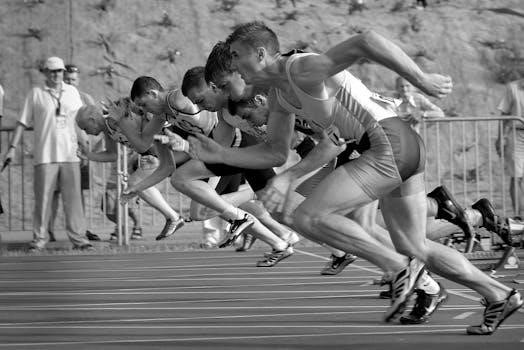Charles Poliquin Workout⁚ A Comprehensive Guide
Embark on a journey into the world of strength training with Charles Poliquin‚ a legendary figure․ This guide explores his unique methodologies‚ from German Volume Training to the 6-12-25 protocol․ Discover principles for hypertrophy‚ nutrition‚ and supplementation‚ all designed to optimize your fitness journey and unlock your potential․
Charles Poliquin‚ a name synonymous with strength training excellence‚ was a Canadian strength coach renowned for his innovative methods and remarkable results․ He wasn’t just a coach; he was a prolific writer‚ contributing over 500 articles to prominent fitness publications‚ sharing his vast knowledge and experience․ Poliquin’s influence extended to training elite athletes‚ including Olympians and professionals across various sports․
His coaching philosophy was rooted in scientific principles and practical application‚ emphasizing individualized training programs tailored to specific needs and goals․ Poliquin advocated for understanding one’s body‚ adopting structured nutrition‚ and utilizing strategic supplementation․ He was a proponent of German Volume Training (GVT) and developed his own training protocols‚ such as the 6-12-25 method‚ designed to maximize muscle growth and strength gains․
Known as the “Strength Sensei‚” Poliquin left an indelible mark on the fitness world‚ inspiring countless individuals to push their boundaries and achieve peak performance․ His legacy continues to influence modern training methodologies‚ making him a true icon in the field of strength and conditioning․
Poliquin’s Training Principles
Charles Poliquin’s training philosophy rested upon a foundation of key principles aimed at optimizing strength and hypertrophy․ He emphasized the importance of individualization‚ recognizing that each athlete responds differently to training stimuli․ Therefore‚ he advocated for tailoring programs to meet specific needs‚ considering factors like muscle fiber composition and training history․
Exercise order was crucial in Poliquin’s approach‚ prioritizing compound movements that engage larger muscle groups before isolation exercises․ This maximized neural drive and hormonal response‚ leading to greater overall gains․ He also stressed the significance of varying rep ranges and intensities to target different muscle fibers and stimulate comprehensive growth․
Tempo‚ the speed at which exercises are performed‚ was another critical element․ Poliquin often prescribed specific tempos to enhance muscle tension and time under tension‚ promoting hypertrophy․ Rest intervals were carefully managed to optimize recovery and hormonal balance․ Furthermore‚ he advocated for periodization‚ strategically varying training parameters over time to prevent plateaus and ensure continuous progress․ Poliquin’s principles provide a roadmap for effective and efficient strength training․
The 6-12-25 Workout Protocol
The 6-12-25 workout protocol‚ a hallmark of Charles Poliquin’s training methods‚ is designed to maximize muscle fiber recruitment and stimulate significant hypertrophy․ This protocol involves performing three exercises for the same muscle group in a tri-set fashion‚ with minimal rest between exercises․
The first exercise is performed for 6 repetitions with a heavy weight‚ targeting the high-threshold muscle fibers responsible for strength․ The second exercise is then performed for 12 repetitions with a moderate weight‚ focusing on hypertrophy and metabolic stress․ Finally‚ the third exercise is performed for 25 repetitions with a lighter weight‚ further exhausting the muscle and promoting muscle endurance․
The key to the 6-12-25 protocol lies in the strategic combination of rep ranges and intensities․ By targeting different muscle fiber types within the same set‚ this protocol creates a potent stimulus for muscle growth․ The minimal rest between exercises further enhances metabolic stress and growth hormone release‚ contributing to increased muscle size and strength․ This protocol is an advanced technique designed for experienced lifters seeking to break through plateaus and achieve rapid results․
Implementing the 6-12-25 Protocol
To effectively implement the 6-12-25 protocol‚ careful exercise selection and proper execution are paramount․ Choose exercises that effectively target the desired muscle group from different angles․ For example‚ when training the chest‚ you might select an incline press (6 reps)‚ a flat dumbbell press (12 reps)‚ and cable flyes (25 reps)․
Rest periods should be kept short‚ typically around 60-90 seconds between tri-sets‚ to maximize metabolic stress․ Focus on maintaining proper form throughout each repetition to avoid injury and ensure optimal muscle activation․ It is crucial to select appropriate weights for each exercise‚ allowing you to reach the target rep ranges with good form․
The 6-12-25 protocol is best suited for intermediate to advanced lifters due to its intensity and volume․ Start with one or two body parts per workout and gradually increase the frequency as your body adapts․ Listen to your body and adjust the protocol as needed to prevent overtraining․ Remember‚ consistency and proper execution are key to reaping the full benefits of this powerful training method․

German Volume Training (GVT) and Poliquin
German Volume Training (GVT)‚ a cornerstone of hypertrophy training‚ found a strong advocate in Charles Poliquin․ GVT‚ characterized by performing 10 sets of 10 repetitions of a single exercise‚ is designed to shock the muscles into growth through high volume and metabolic stress․ Poliquin often incorporated GVT into his programs‚ modifying it to suit individual athlete needs and goals․
Poliquin emphasized the importance of selecting the right exercises for GVT‚ focusing on compound movements that recruit multiple muscle groups․ He also stressed the need for proper form and controlled tempo to maximize muscle fiber recruitment and minimize injury risk․ Rest periods were typically kept short‚ around 60-90 seconds‚ to further enhance metabolic stress and promote muscle growth․
While GVT can be highly effective‚ Poliquin cautioned against its overuse‚ recommending it be implemented strategically and followed by periods of lower volume training to allow for recovery and prevent plateaus․ He believed in tailoring GVT to individual needs‚ adjusting the sets‚ reps‚ and exercises to optimize results based on factors like training experience and muscle fiber type․
Exercise Order According to Poliquin
Charles Poliquin held firm beliefs regarding exercise order‚ viewing it as a critical component of program design․ His approach prioritized neural efficiency and muscle fiber recruitment‚ advocating for a strategic sequencing of exercises to maximize training effectiveness․ Poliquin emphasized that the order in which exercises are performed significantly impacts muscle activation and overall results․
Poliquin’s general guideline was to begin with the most neurologically demanding exercises‚ typically compound movements that engage multiple muscle groups․ These exercises‚ such as squats‚ deadlifts‚ and presses‚ require greater coordination and nervous system activation․ By performing them first‚ athletes can ensure optimal motor unit recruitment and force production․
Following compound exercises‚ Poliquin recommended transitioning to isolation movements that target specific muscles․ This approach allows for focused attention on individual muscle groups after the larger‚ more demanding exercises have been completed․ Poliquin also considered the energy demands of exercises‚ typically placing higher intensity exercises earlier in the workout when energy levels are highest․ He might also alternate between agonist and antagonist muscle groups to optimize recovery and performance․
Poliquin’s Nutritional Recommendations
Charles Poliquin’s nutritional recommendations were as meticulous and precise as his training methodologies․ He strongly believed that nutrition was a cornerstone of athletic performance and overall health․ Poliquin advocated for individualized dietary plans tailored to specific goals‚ body types‚ and activity levels‚ rejecting a one-size-fits-all approach․
Protein intake was a central focus in Poliquin’s nutritional philosophy‚ especially for athletes seeking muscle growth and repair․ He typically recommended a high protein intake‚ often around 1 to 1․5 grams per pound of body weight‚ sourced from high-quality animal products like grass-fed beef‚ wild-caught fish‚ and organic poultry․ Poliquin also emphasized the importance of nutrient timing‚ advocating for protein consumption around workouts to optimize muscle protein synthesis․
Carbohydrate intake was strategically manipulated based on individual needs and goals․ For athletes aiming to gain muscle‚ Poliquin recommended consuming carbohydrates post-workout to replenish glycogen stores and enhance recovery․ However‚ for those focused on fat loss‚ he often advised limiting carbohydrate intake‚ particularly refined sugars and processed foods․ He championed whole‚ unprocessed carbohydrate sources like vegetables and fruits․

Supplementation Strategies by Poliquin

Charles Poliquin was a firm believer in strategically using supplements to enhance athletic performance‚ recovery‚ and overall health․ He didn’t view supplements as replacements for a solid diet and training plan‚ but rather as tools to optimize results when used correctly․ Poliquin’s approach to supplementation was highly individualized‚ considering factors like training intensity‚ dietary habits‚ and specific goals․
Branched-chain amino acids (BCAAs) were a staple in Poliquin’s supplementation protocols․ He emphasized their importance for stimulating muscle protein synthesis‚ reducing muscle breakdown‚ and accelerating recovery‚ especially during intense training periods․ Poliquin often recommended consuming BCAAs before‚ during‚ and after workouts to maximize their benefits․ Creatine monohydrate was another commonly recommended supplement for its ability to enhance strength‚ power‚ and muscle volume․
Beyond BCAAs and creatine‚ Poliquin often incorporated other supplements based on individual needs․ These might include omega-3 fatty acids for their anti-inflammatory properties‚ vitamin D for immune function and bone health‚ and magnesium for muscle relaxation and recovery․ He also advocated for the use of digestive enzymes to improve nutrient absorption and gut health‚ recognizing the crucial role of digestion in overall well-being․
Poliquin’s Approach to Hypertrophy
Charles Poliquin’s approach to hypertrophy‚ or muscle growth‚ was multifaceted and rooted in scientific principles․ He believed in optimizing various training variables to maximize muscle fiber recruitment and stimulate growth․ Volume‚ intensity‚ frequency‚ and exercise selection were all carefully manipulated to create effective hypertrophy programs․
Poliquin emphasized the importance of varying rep ranges to target different muscle fiber types․ He often incorporated low rep ranges (1-5) for strength development‚ moderate rep ranges (6-12) for hypertrophy‚ and higher rep ranges (15+) for metabolic stress and endurance․ He was a proponent of techniques like German Volume Training (GVT) and the 6-12-25 protocol‚ which involved high volume and specific rep schemes to induce significant muscle growth․
Tempo was another crucial element in Poliquin’s hypertrophy training․ He advocated for controlled eccentric (lowering) phases to maximize muscle damage and stimulate growth․ Rest periods were also strategically manipulated to optimize hormonal responses and metabolic stress․ Poliquin believed in using a variety of exercises to target muscles from different angles and ensure complete development․ He also stressed the importance of proper nutrition and supplementation to support muscle growth and recovery․
Poliquin’s Legacy and Impact
Charles Poliquin’s legacy as a strength and conditioning coach is profound and far-reaching․ He left an indelible mark on the fitness industry through his innovative training methodologies‚ prolific writing‚ and dedication to excellence․ Poliquin’s influence extends from elite athletes to everyday fitness enthusiasts‚ shaping the way people approach strength training and muscle development․
His emphasis on scientific principles‚ individualized training‚ and attention to detail revolutionized coaching practices․ He mentored countless coaches and athletes‚ instilling in them a passion for knowledge and a commitment to achieving optimal performance․ Poliquin’s training systems‚ such as German Volume Training and the 6-12-25 method‚ continue to be widely used and adapted by trainers worldwide․
Beyond his specific training techniques‚ Poliquin’s broader impact lies in his holistic approach to fitness․ He emphasized the importance of nutrition‚ supplementation‚ and lifestyle factors in achieving peak physical condition․ His emphasis on customized programs‚ proper execution‚ and relentless pursuit of knowledge continues to inspire those seeking to unlock their full potential․ Poliquin’s legacy endures through the countless individuals he touched and the enduring principles he championed․
Sample Poliquin-Inspired Workout Routine
This sample routine incorporates Poliquin’s principles‚ emphasizing compound movements and strategic rep ranges for hypertrophy․ Remember to adjust weights based on your individual strength levels․ Prioritize proper form and controlled movements․
Day 1⁚ Upper Body Strength
- A1⁚ Incline Dumbbell Press⁚ 4 sets of 6-8 reps‚ 90 seconds rest
- A2⁚ Weighted Pull-ups⁚ 4 sets of 6-8 reps‚ 90 seconds rest
- B1⁚ Seated Dumbbell Shoulder Press⁚ 3 sets of 10-12 reps‚ 60 seconds rest
- B2⁚ Barbell Rows⁚ 3 sets of 10-12 reps‚ 60 seconds rest
- C1⁚ Dumbbell Bicep Curls⁚ 3 sets of 12-15 reps‚ 45 seconds rest
- C2⁚ Triceps Pushdowns⁚ 3 sets of 12-15 reps‚ 45 seconds rest

Day 2⁚ Lower Body Strength
- A1⁚ Barbell Back Squats⁚ 4 sets of 6-8 reps‚ 90 seconds rest
- A2⁚ Romanian Deadlifts⁚ 4 sets of 8-10 reps‚ 90 seconds rest
- B1⁚ Leg Press⁚ 3 sets of 10-12 reps‚ 60 seconds rest
- B2⁚ Leg Curls⁚ 3 sets of 12-15 reps‚ 60 seconds rest
- C1⁚ Standing Calf Raises⁚ 4 sets of 15-20 reps‚ 45 seconds rest
Rest at least one day between workouts․ Focus on progressive overload‚ gradually increasing weight or reps over time․
